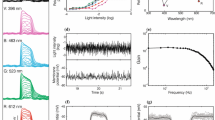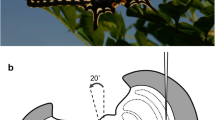Summary
-
1.
The butterfly retina exhibits strong interactions between photoreceptor responses recorded intracellularly. In general, the receptor which is locally giving the largest response suppresses the responses of neighbouring receptors that are less strongly stimulated. The effect enhances the differences between the primary photo-receptors and reduces responses to stimuli that excite all receptors together.
-
2.
The interaction is explained in terms of a high extracellular resistance, so that receptor currents pass through other receptors in the opposite direction to those of their own responses. The result is that receptors are actively turned off by colours away from their own peak wavelength.
-
3.
This effect applies most strongly to colour and to polarization plane when the stimulus is a point source on axis, and is therefore strong between the receptors of the same ommatidium.
-
4.
The result is that spectral sensitivity peaks and angular sensitivity peaks are narrower, and polarisation sensitivity is greater, than expected from single retinula cells in isolation. The sensitivities measured electrophysiologically cannot be easily related to the physical properties of the visual pigments. Polarisation sensitivity (PS) can reach 50.
-
5.
There are four types of primary photoreceptor, with peak near 380 nm, 450 nm, 550 nm and 610 nm. Cell marking usually reveals these as single retinula cells. Near the peak spectral sensitivity the responses are up to 60 mV positive-going, but away from the peak they can be negative-going.
-
6.
Anatomically the retina ofPapilio has four distal, four proximal retinula cells, and a ninth basal cell. Narrow pigment cells and tracheoles squeeze through the substantial basement membrane along with each bundle of nine axons.
-
7.
Two of the distal retinula cells contain red pigment grains near the rhabdom. The distal retinula cells are UV or blue sensitive. Green sensitive cells are proximal and can be coupled in opposite pairs. Red sensitive cells are proximal.
-
8.
The UV sensitive cell with peak near 380 nm is the most sensitive of the cell types when measured by the position of theV/logI curve on the intensity axis at the spectral peak of each type. The red-sensitive cells are also sensitive. By its inhibitory effect, interaction between receptors reduces the sensitivity measurement on this scale.
-
9.
Angular sensitivities measured with positive-going responses near the spectral peaks are narrow (Δρ-2°); when measured with negative-going responses they are wider (Δρ=3° to 5°).
-
10.
One type of unit has only negative-going responses to −60 mV, with Δp=2° to 5°, spectral peak near 550 nm and sometimes also 380 nm or 450 nm. This type has not been marked and is regarded as a restricted channel for return current. ItsV/logI curve extends over an intensity range of 106.
-
11.
The variety of the units suggests that their responses are not due to a simple regular network with all units connected indiscriminately to all others at all times through their terminals. There are selective channels for current flow and some retinula cells appear to be little influenced by others.
-
12.
Theory shows that when there is a direct electrical coupling between a pair of retinula cells (not passing through the extracellular space) it is possible to balance out the negative interactions caused by current flow through their terminals. Far from degenerating the signals, direct electrical coupling can cancel the negative interaction, and this may be its normal function.
Similar content being viewed by others
References
Autrum H, Burkhardt D (1960) Die spektrale Empfindlichkeit einzelner Sehzellen. Naturwissenschaften 47:527
Bernard GD (1979) Red-absorbing visual pigment of butterflies. Science 203:1125–1127
Blest AD, Stowe S, Eddey W (1982a) A labile Ca2+ dependent cytoskeleton in rhabdomeral microvilli of blowflies. Cell Tissue Res 223:553–573
Blest AD, Stowe S, Eddey W, Williams DS (1982b) The local deletion of a microvillar cytoskeleton from photoreceptors of tipulid flies during membrane turnover. Proc R Soc Lond [Biol] 215:469–479
Crane J (1955) Imaginal behavior of a Trinidad butterfly with special reference to the social use of color. Zoologica NY 40:167–196
Dartnall HJA (1953) The interpretation of spectral sensitivity curves. Br Med Bull 9:24–30
Detwiler PB, Hodgkin AJ (1979) Electrical coupling between cones in turtle retina. J Physiol 291:75–100
Höglund G, Hamdorf K, Rosner G (1973) Trichromatic visual system in an insect and its sensitivity control by blue light. J Comp Physiol 86:215–229
Langer H, Hamann B, Meinecke CC (1979) Tetrachromatic visual system in the mothSpodoptera exempta. J Comp Physiol 129:235–239
Lasansky A (1967) Cell junctions in ommatidia ofLimulus. Cell Biol 33:365–383
Laughlin SB (1981) Neural principles in the peripheral visual systems of invertebrates. In: Autrum H (ed) Handbook of sensory physiology, vol VII/6B. Springer, Berlin, Heidelberg, New York, pp 133–280
Mazochin-Porschnyakov GA (1973) Insect vision. Plenum Press, New York
Menzel R (1979) Spectral sensitivity and color vision in invertebrates. In: Autrum H (ed) Handbook of sensory physiology, vol VII 7/6A. Springer, Berlin Heidelberg New York, pp 504–580
Menzel R, Blakers M (1976) Colour receptors in the bee eye. Morphology and spectral sensitivity. J Comp Physiol 108:11–33
Muller KJ (1973) Photoreceptors in the crayfish compound eye: electrical interactions between cells as related to polarized light sensitivity. J Physiol (Lond) 232:573–596
Naka KI, Kuwabara K (1959) Response of a single retinula cell to polarized light. Nature 184:455–456
Raviola E, Gilula NB (1973) Gap junctions between photoreceptor cells in the vertebrate retina. Proc Natl Acad Sci USA 70:1677–81
Schlecht P, Hamdorf K, Langer H (1978) The arrangement of colour receptors in a fused rhabdom of an insect. J Comp Physiol 123:239–243
Schwemer J, Paulsen R (1973) Three visual pigments inDeilephila elpenor (Lepidoptera: Sphingidae). J Comp Physiol 86:215–229
Shaw SR (1969) Interreceptor coupling in ommatidia of drone honeybee and locust compound eyes. Vision Res 9:999–1029
Shaw SR (1975) Retinal resistance barriers and electrical lateral inhibition. Nature 255:480–483
Shaw SR (1978) Signal transmission by graded slow potentials in the arthropod peripheral visual system. In: The neurosciences: 4th study program. MIT Press, Cambridge (Massachusetts) London, pp 275–479
Shaw SR (1981) Anatomy and physiology of identified nonspiking cells in the photoreceptor-lamina complex of the compound eye of insects, especially Diptera. In: Roberts A, Bush BMH (eds) Neurones without impulses. Cambridge University Press, Cambridge (Massachusetts), pp 61–116
Stewart WW (1978) Functional connections between cells as revealed by dye-coupling with a highly fluorescent naphthalimide tracer. Cell 14:741–759
Struwe G (1972) Spectral sensitivity of single photoreceptors in the compound eye of a tropical butterfly (Heliconius numata). J Comp Physiol 79:197–201
Swihart SL (1970) The neural basis of colour vision in the butterfly,Papilio troilus. J Insect Physiol 16:1623–1636
Swihart SL (1972) Modelling the butterfly visual pathway. J Insect Physiol 18:1915–1928
Swihart SL (1974) Acceptance angles of butterfly ommatidia. J Insect Physiol 20:1027–1036
Author information
Authors and Affiliations
Rights and permissions
About this article
Cite this article
Horridge, G.A., Marčelja, L., Jahnke, R. et al. Single electrode studies on the retina of the butterflyPapilio . J. Comp. Physiol. 150, 271–294 (1983). https://doi.org/10.1007/BF00605018
Accepted:
Issue Date:
DOI: https://doi.org/10.1007/BF00605018




